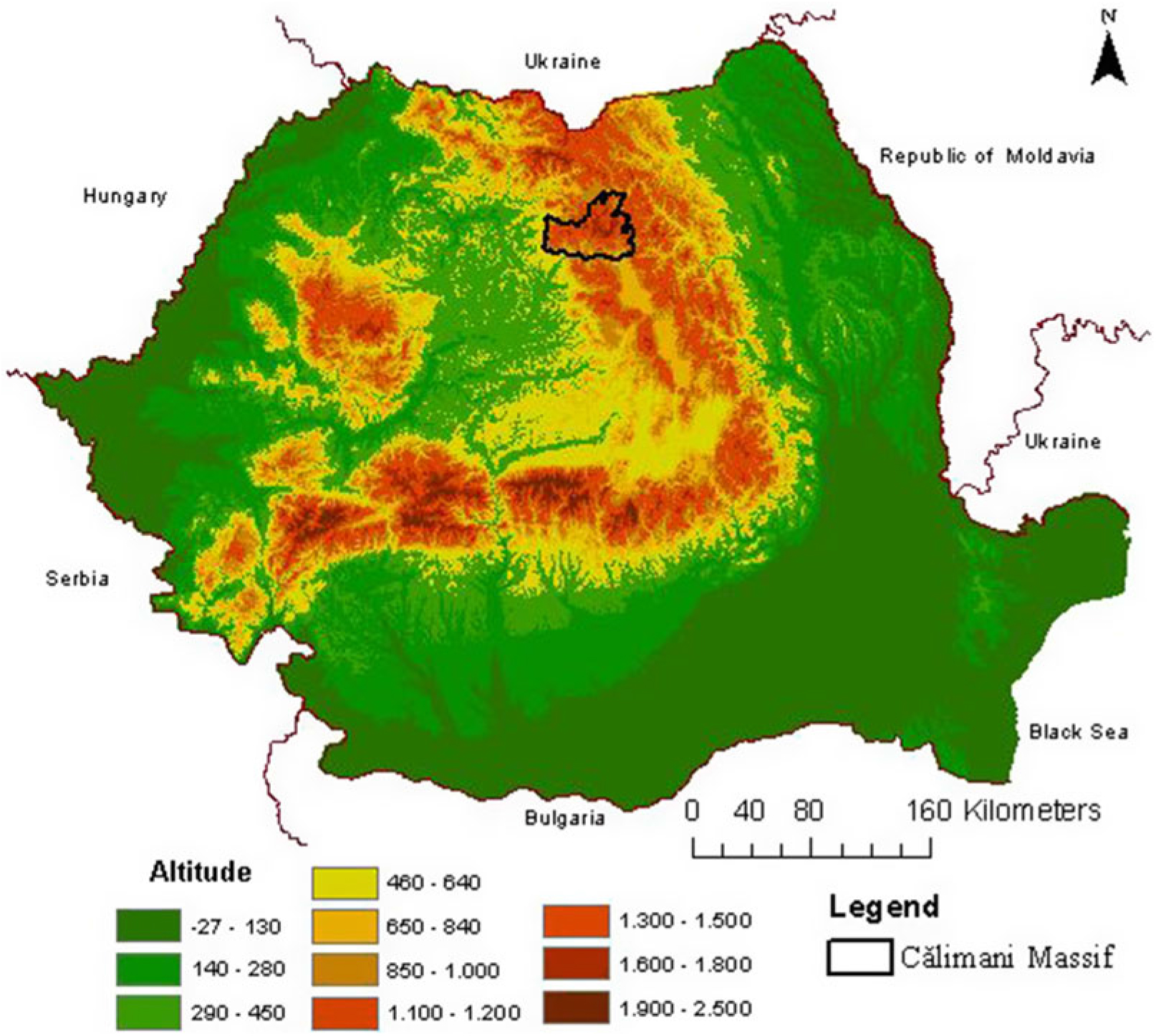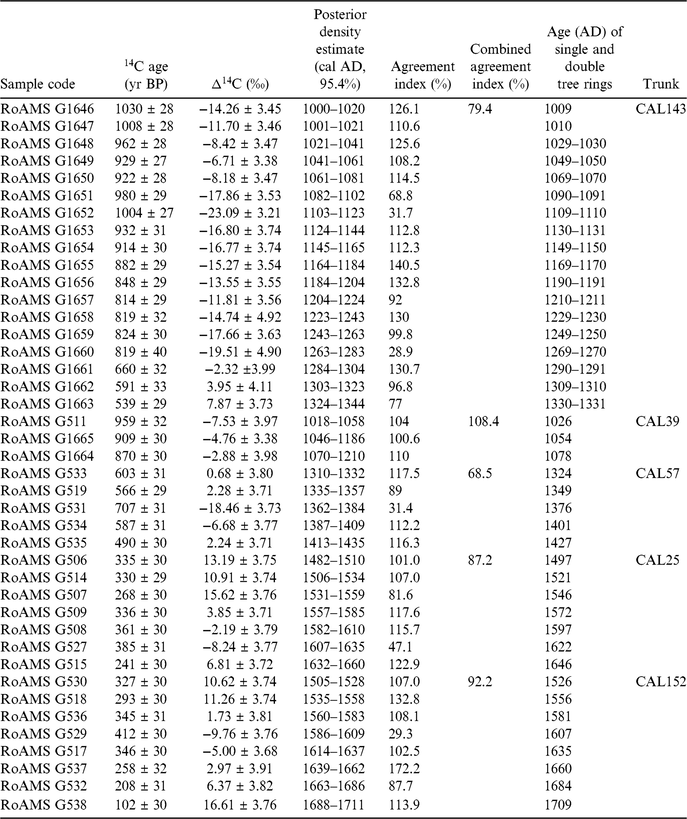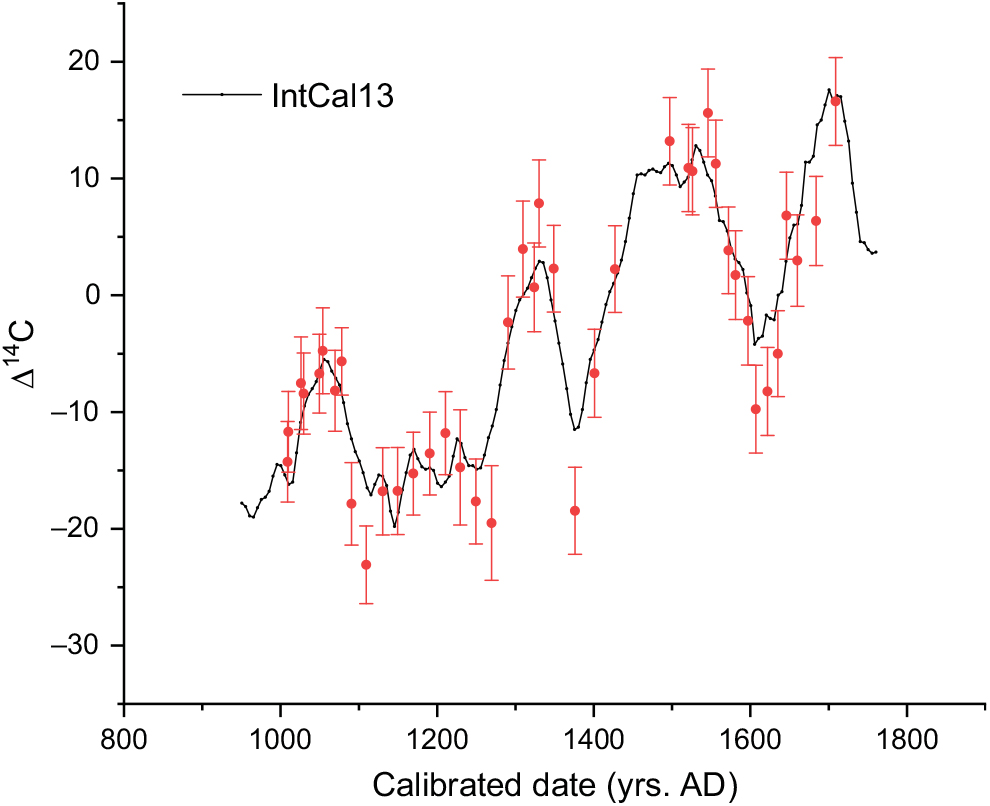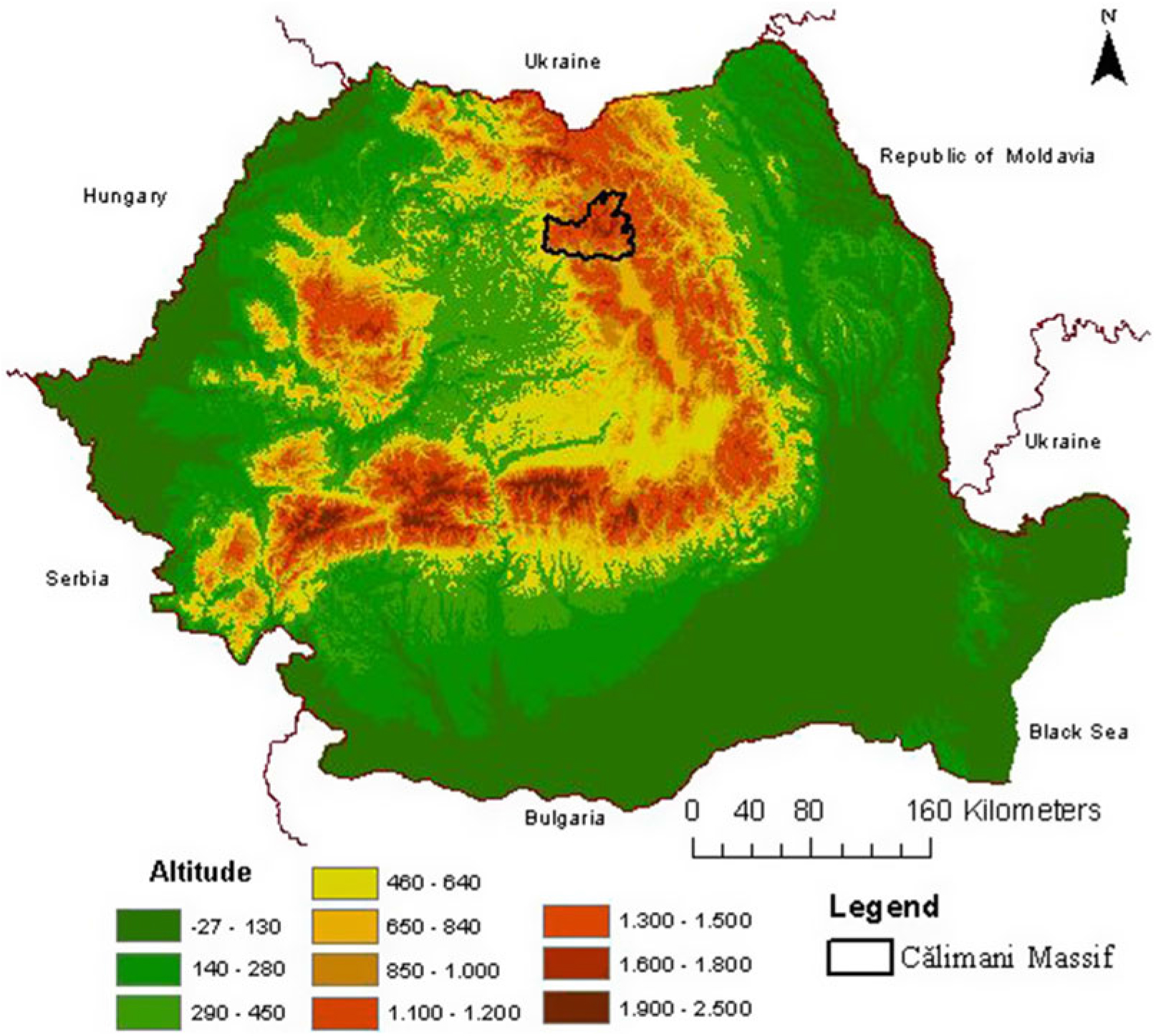INTRODUCTION
Radiocarbon (14C) dating and dendrochronology are recognized partner methods. It is well known that the 14C dating method is based on calibration via an independent dating method. For this purpose, dendrochronology offers the absolute dating information with annual resolution, which is necessary to reconstruct the atmospheric 14C levels from the past. While dendrochronology carries the particularities of the region where the sample grows, 14C dating can be applied globally due to the fast mixing of CO2 in the atmosphere. However, the 14C production and distribution among carbon reservoirs may show specific levels of atmospheric 14C in different regions of the globe due to climatic conditions. (i.e. Hong et al. Reference Hong, Park, Park, Sung, Park and Lee2013; Manning et al. Reference Manning, Griggs, Lorentzen, Ramsey, Chivall, Jull and Lange2018). These levels are influenced by a mixing of natural activities such as climate changes, volcanic eruptions, and ocean proximity with anthropogenic factors including nuclear bomb tests and the burning of fossil fuels. The basis of the IntCal calibration curves for the last 12 kyr are the chronologies established on Irish oaks, German oaks, and European pine trees, as well as bristlecone pine trees from the North American continent (Washington, Oregon, California, and Alaska) after careful intercomparisons (Reimer et al. Reference Reimer, Bard, Bayliss, Beck, Blackwell, Ramsey, Buck, Cheng, Edwards, Friedrich, Grootes, Guilderson, Haflidason, Hajdas, Hatté, Heaton, Hoffmann, Hogg, Hughen, Kaiser, Kromer, Manning, Niu, Reimer, Richards, Scott, Southon, Staff, Turney and van der Plicht2013).
Since 2015, the year of its official foundation, the RoAMS laboratory in Bucharest has begun a series of 14C determinations on samples from archaeological sites spread all over the Romanian territory (R.A.N. 2018). In this regard, archaeologists often raised questions about the observation and analysis of any particular regional signature of the 14C atmospheric levels. Some of these questions are the result of the observed dendrochronology differences in the tree-ring patterns growing in the southern and central-north parts of the European continent, which were observed in the oak chronologies (Ważny Reference Ważny2009; Ważny et al. Reference Ważny, Lorentzen, Köse, Akkemik, Boltryk, Güner, Kyncl, Kyncl, Nechita, Sagaydak and Vasileva2014). To reveal and interpret these differences new attempts were taken to bridge the oak chronologies from wider Mediterranean region to the Northern regions (Pearson et al. Reference Pearson, Ważny, Kuniholm, Botić, Durman and Seufer2014). In the Moldova region of Romania, floating chronologies of oak and elm subfossils collected along the course of Suceava River (Rădoane et al. Reference Rădoane, Nechita, Chiriloaei, Rădoane, Popa, Roibu and Robu2015, Reference Rădoane, Chiriloaei, Sava, Nechita, Rădoane and Gâza2018) have been studied by Kern and Popa (Reference Kern and Popa2016). However, there are certain cases where dendrochronology cannot deliver calendar dates as discussed in Bayliss et al. (Reference Bayliss, Marshall, Tyers, Ramsey, Cook, Freeman and Griffiths2017) and which can originate in (1) different tree species between the sample and the available reference chronology; (2) reduced number of tree rings in the sample, usually 50 tree rings are normally required for a reliable dendrochronology; and (3) mismatch between tree-ring sequence and the dendrochronology master-curve. In the following we will provide an example from this last case, where the alternative method of 14C “wiggle-matching” was employed to validate and secure a suspiciously misplaced dendrochronology cross-matching.
SAMPLE COLLECTION AND DENDROCHRONOLOGY
The test was performed on five subfossil wood trunks of cembra pine (Pinus cembra) collected from Călimani Mountains, Eastern Carpathians (47°06′30″N, 25°15′10″E and 1750 m asl), Figure 1. Wood samples, namely CAL25 (t-value 18.2, Glk 69, CDI 86), CAL39 (t-value 1.6, Glk 65, CDI 34), CAL57 (t-value 7.3, Glk 63, CDI 84), CAL143 (t-value 23.8, Glk 63, CDI 76) and CAL152 (t-value 7.2, Glk 52, CDI 20) are from a larger millennial-scale dendrochronological dataset, based on living and dead wood samples, established for paleoclimate reconstruction (Popa and Kern Reference Popa and Kern2009). All the samples were prepared in accordance to the standard dendrochronological methodology (Cook and Kairiukstis Reference Cook and Kairiukstis1990), using t-value, coefficient of coincidence Gleichläufigkeit (Glk), correlation coefficient (c coeff), and cross-date index (CDI) as cross-dating parameters (Rinn Reference Rinn2010). The 41 single and double tree-rings were split from these trunks at a chosen interval of around 25–30 yr, which represents the routine standard deviation of our 14C determinations. The time period covered by these samples spread from the year 1009 AD to 1709 AD. TSAP-WinTM 4.81 software package was used for dendrochronology.

Figure 1 Călimani Mountains in the Eastern Carpathians, where the samples were collected.
14C MEASUREMENT AND DATING METHODOLOGY
The AMS 14C dating method of wood samples requires cellulose extraction and purification for reliable and reproducible results. The chemical pretreatment followed the standard (base-acid-base-acid-bleaching) BABAB laboratory protocol (Sava et al. Reference Sava, Simion, Gâza, Stanciu, Păceşilă, Sava, Wacker, Ştefan, Moşu, Ghiţă and Vasiliu2018), while for the graphitization stage we used an AGE III automated system, manufactured by Ionplus AG, (Wacker et al. Reference Wacker, Němec and Bourquin2010a). All the samples were normalized against NIST 4990C—Oxalic Acid II (NIST 1983) modern reference standard and background corrected using SIRI Sample L (pMCavg = 0.28 ± 0.06; Scott et al. Reference Scott, Naysmith and Cook2017). The 14C/12C isotopic ratios were δ13C corrected for natural and induced fractionation by simultaneously measuring the 13C/12C ratio. The measurement was performed on our 1 MV AMS system. The measurement time was divided in 12 sections, each section of 300 sec, thus totalizing 60 min measurement time for each sample. The AMS analysis was taken on the +2 charge state at typical currents of ~ 25µA of 12C, while the terminal voltage was set at 1MV. The resulting data was analyzed using BATS software (Wacker et al. Reference Wacker, Christl and Synal2010b) in accordance with Stuiver and Polach (Reference Stuiver and Polach1977).
The resulted 14C ages were wiggle-matched using OxCal v4 3.2 (Ramsey Reference Ramsey1995) D-Sequence function and IntCal13 (Reimer et al. Reference Reimer, Bard, Bayliss, Beck, Blackwell, Ramsey, Buck, Cheng, Edwards, Friedrich, Grootes, Guilderson, Haflidason, Hajdas, Hatté, Heaton, Hoffmann, Hogg, Hughen, Kaiser, Kromer, Manning, Niu, Reimer, Richards, Scott, Southon, Staff, Turney and van der Plicht2013) calibration data. This technique basically fits the obtained data to the shape of the calibration curve. As described in Ramsey et al. (Reference Ramsey, van der Plicht and Weninger2001), for the generation of the agreement factors for individual rings, which are essentially an estimate of the goodness of the fit, a Bayesian probabilistic approach is employed to relate the posterior probability distribution to the likelihood distribution using an overlap integral. Subsequently, the overall agreement is defined as a product of all the individual agreement factors in the wiggle-match to the power 1/√n. Various dependencies of the method precision upon parameters like the number of analyzed samples (tree rings), 14C determination uncertainty, and general profile of the calibration curve are quantized in Galimberti et al. (Reference Galimberti, Ramsey and Manning2004).
RESULTS AND DISCUSSIONS
Table 1 lists the obtained 14C ages modeled by wiggle-matching according to agreement and combined agreement indices, as well as Δ14C for each sample.
Table 1 Results of 14C determinations in 41 tree-ring samples (1009–1709 AD) correlated via wiggle-matching and grouped in 5 distinct wood trunks. Age (AD) was determined by dendrochronology. The uncertainties represent 1σ.

All the determined 14C ages were found to be in good agreement, at 95.4% confidence, with the dendrochronology ages (Table 1). However, the initial dendrochronology cross-matching established for trunk CAL57 was indicating a 48-yr younger position with respect to the present moment, which was further considered to be inconsistent. This position was susceptible for correction due to its mismatch with the 14C posterior density estimates delivered by wiggle-matching. Given the discrepancies between the two age sets obtained for the same wood sample we decided to check the accuracy of our 14C determinations modeled by OxCal wiggle-matching and IntCal13 dataset on a second dendrochronology sequence covering the same age period, 1300–1450 AD, but built on old wood beams of oak (Quercus sp.) from Transylvanian medieval churches (Botár et al. Reference Botár, Boglárka and Grynaeus2015). The ages obtained during this quality assurance test showed an excellent agreement, confirming the reliability of our measurements and dating methodology.
Hence, the previous and most probable CAL57 cross-matching described by a t-value of 14.9 and an age interval of [1349–1796 AD] was changed to a new position characterized by a lower t-value of 7.3 and a corresponding age interval of [1301–1748 AD]. This new position, which agrees the 14C ages, was also indicated as the next maximum of the probability density function in the dendrochronology analysis.
By applying the Bayesian wiggle-matching technique, the calibrated age intervals have been considerably reduced, thus allowing precise and reproducible calendric ages to be obtained. The combined agreement indices Acomb for all the samples stemming from single trunks showed very good agreement: Acomb_CAL143 = 79.4%, Acomb_CAL39 = 108.4%, Acomb_CAL57 = 68.5%, Acomb_CAL25 = 87.2% and Acomb_CAL152 = 92.2%. The precision of the wiggle-matching varied with the number of the analyzed samples, achieving 40 yr. uncertainty for CAL39 (three samples) down to 20 yr. uncertainty for CAL143 (18 samples). However, an excellent value of 22 yr was obtained for CAL57 with only five analyzed samples, as previously demonstrated in Galimberti et al. (Reference Galimberti, Ramsey and Manning2004).
The deviations of the 14C concentration of all the tree-rings with respect to their year of growing were estimated by calculating the Δ14C using the relation:
Where y is the year (AD) when the ring was grown and 1/λ=t1/2/ln(2) = 8267 is the mean life-time for the real 14C half-life, 5730 years. The pMC was measured and corrected as discussed in the previous paragraph on 14C AMS measurement. The Δ14C results are plotted in Figure 2 with the IntCal13 data for comparison. The average deviation for the measured points was found –0.63 ± 3.76‰, which is a much smaller value compared to the statistical error. Therefore, this deviation can be ignored when using IntCal data for calibration of 14C ages of Romanian samples.

Figure 2 Δ14C of the 41 cembra pine single and double tree-ring samples collected from Eastern Carpathians. The continuous line represents the IntCal13 data.
The values obtained for the Δ14C closely replicate the solar activity events recorded in tree-rings 14C concentration variations for the Northern Hemisphere (Stuiver Reference Stuiver1980), overlapping the Little Ice Age period for 1350–1709 AD.
CONCLUSIONS
A number of 41 single and double tree-ring samples spanning AD 1009–1709 were measured to verify the consistency of the IntCal data with the local samples. The 14C concentration offset relative to IntCal was found to be remarkably reduced, showing a Δ14C of –0.63 ± 3.76‰, thus highlighting the validity of using the data included in Intcal13 calibration curve for the Romanian samples.
The 14C wiggle-matching was used to support the dendrochronology analysis for the cembra pine wood samples. These results proved the maturity of RoAMS 14C determinations as well as the well-established IntCal data and weight of the OxCal mathematical construct.
Pinus cembra can be used as a proxy for determination of the 14C variability, but extra information is recommended to be employed for the validation of the cross-matching. In this regard, the 14C wiggle-matching can offer reliable age information even with a reduced number (5–7) of measured and modeled tree-rings.
SUPPLEMENTARY MATERIAL
To view supplementary material for this article, please visit https://doi.org/10.1017/RDC.2019.56.
AKNOWLEDGMENTS
We thank to Isvan Botár from Anno Domini Dendrolab for the interesting discussions about dendrochronology and to two unknown reviewers for their constructive comments.





